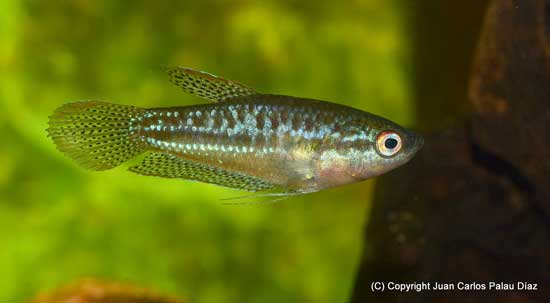Sparling Gourami - Overview

Sparling Gourami
The Sparkling Gourami originated from shallow puddles in the Thailand area. It is sensitive to water conditions and is not a good beginner fish. The Sparkling Gourami is also known as the Pygmy Gourami because of its small size and the Dwarf Croaking Gourami because of the clicking noise it can make during breeding. It is closely related to the Croaking Gourami. The body does not have the depth typical of other gouramis. It has dark spots or a dark band running laterally through its mid line. There are also spots of iridescent blue and green.
Sparling Gourami - Aquarium Setup
The Sparkling Gourami does have a long thread-like pelvic fin, which is typical of gouramis. Sparkling Gouramis are a good community fish, but males can be quite territorial toward each other, especially during breeding. In order to reduce aggression groups of more than 3 with more females than males are recommended. The tank should be well planted and have hiding areas of rocks or driftwood. A large tank is not necessary, which is also not typical of other gouramis.
Sparling Gourami - Compatibility:
Sparling Gouramis are compatible with Bala Sharks, Clown Loaches, Corydoras, Danios,
Gouramis, Hatchetfish, Kuhli Loaches, Liveberarers,
Plecos,
Rainbowfish, Rainbow
Shark, Red Tailed Shark, White Clouds.
Sparling Gouramis are not compatible with Cichlids.
Sparling Gourami - Feeding
Similar to the Betta and other anabantids, the the Sparkling Gourami is a labyrinth fish, which means it can breathe air directly and will frequent the top of the tank. Sparkling Gouramis can survive in poorly oxygenated water. They will eat flake food, algae flakes, pellets and tubifex. They will benefit from occasional live brine shrimp. They will also eat small live snails.
Sparling Gourami - Breeding
Males are difficult to distinguish from females. Colors for both will increase during breeding, which can happen monthly. Breeding is best accomplished by obtaining a group of six or more fish and watching for pairings. When they are ready to spawn, the male builds a bubblenest under leaves at the surface and then dances and wraps around the female. The male ensures the rising eggs reach the bubblenest. The spawning process can be repeated several times over a number of hours. About 10 eggs are released at a time, with a total of over a hundred eventually being achieved in some cases. The female should be removed after spawning. The male will guard the nest and young fry. The fry hatch in a couple of days. The male should be removed when the fry swim free. The fry should be fed infusoria and then brine shrimp.
Sparling Gourami - Profile
-
Scientific Name: Trichopsis pumila
-
Family: Anabantid
-
Temperature: 25 - 28 C; 77 - 82 F
-
pH: 6.0 - 7.0
-
Size: 4 cm; 1.5 inches
-
Life Span: 2 years
-
Breeding: Difficult, Bubble Nest